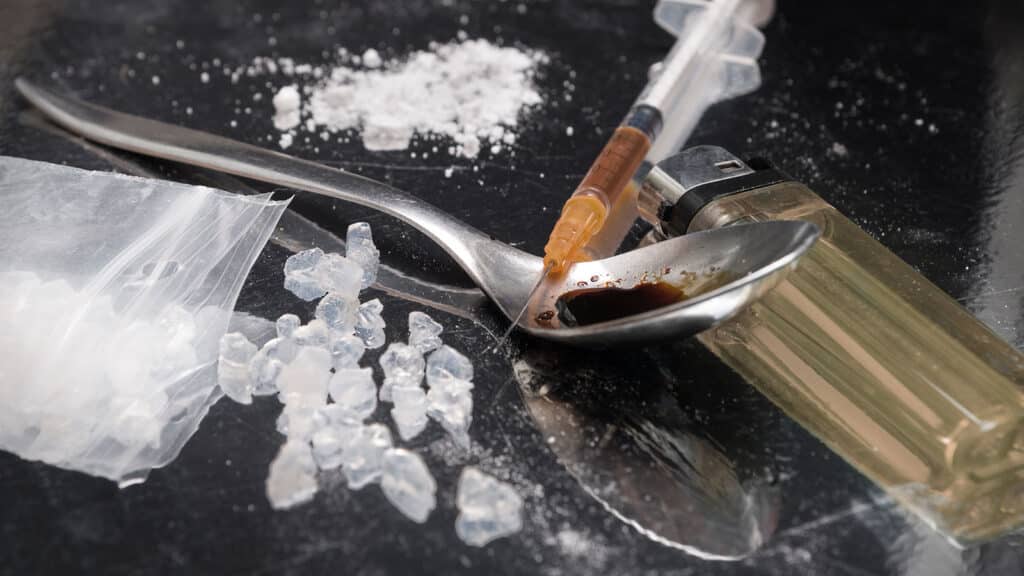Meth comes in lots of shapes, colors, and purity levels. Sometimes, it’s sold as glass-like chunks. People call these shards ice or crystal meth.
How is ice different from powdered meth? Is it more dangerous?
To help you answer these questions, we put together a thorough meth vs. ice comparison. Read on to understand the risks associated with abusing this drug in its different forms.
Table of Contents
- 1 Meth vs. Ice: At a Glance
- 2 7 Key Differences Between Ice and Other Forms of Meth
- 2.1 1. Purity: Ice Is a More Potent Form of the Drug
- 2.2 2. Appearance: Ice Is Crystalline and Often Colorless
- 2.3 3. Perceived Euphoria: The Rush Is More Intense With Ice Use (But So Is the Following Crash)
- 2.4 4. Overdose Risk: Ice Abuse Carries a High Toxicity Risk
- 2.5 5. Routes of Administration: There Are a Lot of Ways to Use Ice
- 2.6 6. Action Speed: Effects of Smoked Ice Are Felt Almost Immediately
- 2.7 7. Risk From Experimental Use: Ice Has Low Prevalence and High Perceived Risk
- 3 Final Thoughts: No Form Meth Is Safe, But Recovery Is Possible
- 4 Helpful Resources
Meth vs. Ice: At a Glance
We’ll cover a detailed comparison between the two drugs in a minute. For now, here’s a quick overview to check out:
| Ice (Crystal Meth) | Other Types of Meth | |
| Drug Type | Stimulant Methamphetamine | Stimulant Methamphetamine |
| Form | Crystalline | Fine powder, pills, or oil |
| Color | Colorless or blue-white | White or brownish-yellow |
| Potency | High | Lower |
| Street Names | Glass, Tina, shards, and puff | Meth, speed, base, wax, and melt |
| Most Common Abuse Method | Smoking and injecting | Snorting, swallowing, and injecting |
Both Are Illicit Methamphetamines
Both stimulant drugs belong to the same class of illicit substances; they’re both methamphetamine-based.
As we’ve already established, when people say “ice,” they’re referring to a crystalline form of methamphetamine.
Methamphetamine is a man-made drug that was used widely during WWII. Because it’s a central nervous system stimulant that increases the effect of dopamine, it was used to boost energy levels and create a sense of euphoria among the troops.
In the 1950s, it was also available as a weight-loss. By then, people had started using recreationally as well.
Today, however, only one product containing methamphetamine is FDA-approved. This is the prescription drug Desoxyn, which is used to help manage attention deficit hyperactivity disorder (ADHD).
All other forms of methamphetamine on the market are produced and sold illegally, including ice.
Both Are Incredibly Dangerous and Addictive
Despite the differences in form and purity, all types of meth are still highly addictive and damaging to a person’s physical and mental health.
Chronic use can lead to psychosis, violent behavior, cardiovascular problems, and impaired cognitive function. Severe dental decay (meth mouth) is one of the most common long-term effects, too.
In the short-term, crystal and powder meth will both cause side effects like increased heart rate, hyperthermia (overheating), agitation, and insomnia.

7 Key Differences Between Ice and Other Forms of Meth
We’ve covered that the top similarity between ice and regular meth is that they’re both made from the highly addictive methamphetamine stimulant.
Now, let’s take a closer look at what sets the crystalline form apart from the other forms of illicit meth. The main differences are in concentration, appearance, and associated risk.
1. Purity: Ice Is a More Potent Form of the Drug
Out of all the types of meth out there, the crystalline form (ice) is the most potent.
Yet, it’s hard to identify the exact concentration. After all, these products are illicit and thus not subject to regulations or pharmaceutical formulation standards. They might have even been cooked in a small-scale chemistry lab.
That said, some sources estimate if the powder meth (speed) is only 10–20% pure, then ice’s concentration would be around 80%. This makes it a powerful stimulant compared to other types of illicit meth.
It’s also worth noting that crystal meth products seem to be getting more potent with time. For instance, half of the samples tested back in early 2011 had a purity level of 10% or less. However, by 2014, the average drug had reached a concentration of 75–80%.
2. Appearance: Ice Is Crystalline and Often Colorless
Crystal meth has a shiny, rock-like appearance, which makes it look a lot like glass shards. In some cases, ice has a blue-white hue. Either way, the crystals come in different shapes and sizes.
Other forms of methamphetamine are white or yellowish. The fine powder, for instance, is typically white or off-white. Meanwhile, the thick, oily base is yellowish.
Non-crystalline forms of meth may smell and taste rather bitter, while ice is often odorless.
Side Note: The meth powder is sometimes pressed and used to fill pills.
3. Perceived Euphoria: The Rush Is More Intense With Ice Use (But So Is the Following Crash)
All types of meth target the dopamine reward pathway in the brain. This means that they manipulate motivation, compulsion, and euphoria levels.
The “experience” begins with a short-lived rush. The heart races, and the blood pressure increases. Next comes the high itself, which can last for hours.
After the high, the person usually goes through a binge phase or a strong urge to maintain the high. To do that, they need even more meth. If they don’t get it, they start to crash. That’s when the body shuts down because it’s unable to cope without the drug.
All aspects of this substance abuse experience apply to powder, oily, and crystal methamphetamine. However, since the crystal form is the most potent, it’s believed to cause a more intense high. Of course, the crash that follows is also going to be more intense.
The withdrawal symptoms are so dangerous that the detox is best done in a medical environment.
At Recreate Life Counseling, our meth addiction treatment programs factor in the pain, depression, mood swings, and intense cravings that come with the withdrawals. Healthcare professionals are always there to make sure the detoxification process is as safe as possible.
4. Overdose Risk: Ice Abuse Carries a High Toxicity Risk
The purity level doesn’t just translate to a stronger high. It can also mean an increased risk of overdose.
For one, ice is more concentrated, which makes toxic reactions even more likely. Plus, the high purity can lead to more pronounced binge-consumption behavior. If more meth is available, this will increase the risk of an overdose as well.
It’s worth noting that meth overdoses, in general, are quite fatal since it can come with threatening cardiovascular events. Think strokes and heart attacks. The symptoms may include difficulty breathing, chest pain, seizure fits, and loss of consciousness.
Meth is actually the second most commonly found substance in overdose fatalities, right after synthetic opioids. Plus, the deaths from psycho-stimulants (like meth) jumped from 24,576 in 2020 to 32,856 in 2021!
If you suspect someone has overdosed on ice or any other meth product, call 911 immediately.
5. Routes of Administration: There Are a Lot of Ways to Use Ice
Ice could be snorted, shelved/shafted, or swallowed.
However, the most popular methods of abuse are smoking and injecting. That’s why syringes and glass pipes are common paraphernalia among people suffering from a crystal meth substance use disorder.
Meanwhile, the oily base form is mostly injected. People who abuse the powder form might resort to snorting, swallowing, or injecting.
6. Action Speed: Effects of Smoked Ice Are Felt Almost Immediately
How fast the drug kicks in depends on the route of administration more than the form.
When smoked, meth causes effects nearly immediately. Injections take 15–30 seconds. Snorting, however, delays the action a bit, causing the first signs to appear after 5 minutes or so.
The slowest route of them all is ingestion. When swallowed, the drug can take up to 20 minutes to kick in.
Since ice is typically either smoked or injected, it’s thought of as fast-acting. The euphoric effects of ice can last anywhere between 6 and 12 hours.
7. Risk From Experimental Use: Ice Has Low Prevalence and High Perceived Risk
Unfortunately, there isn’t much information about the trends and prevalence of ice vs. other types of meth. That’s because most surveys on illicit drug use don’t distinguish between the forms. The statistics just provide an overall look at methamphetamine abuse.
That said, the Monitoring the Future report from the University of Michigan shows that the lifetime prevalence of ice among school students (grade 12) is under 1% and has been for a while. The annual prevalence is dropping as well.
When the students were asked to rate the risk from experimental use (the risk associated with trying a drug just once or twice), many of them placed crystal meth at the top of the list. The report shows that the perceived risk actually increased by six points from 2023 to 2024.
Hopefully, this is a sign that drug awareness education is working and will continue to pay off in the long term.
Final Thoughts: No Form Meth Is Safe, But Recovery Is Possible
Ice’s high purity level makes it highly addictive and more likely to cause a fatal overdose. But that’s not to say that the other types of the drug are safe; there’s no safe way to use illicit meth.
Whether in crystalline or powder form, meth is linked with serious long-term effects, from permanent damage to the blood vessels in the heart and brain to severe tooth decay.
The strong psychological dependence also makes meth addiction a particularly hard habit to kick. But full recovery is still possible.
If you or someone you love is struggling with addiction to methamphetamines, please contact Recreate Life Counseling for information about the available treatment options.
Helpful Resources
- DEA: Methamphetamine Drug Fact Sheet
- US Department of Justice: Meth Awareness
- CMA: Crystal Meth Anonymous Meetings in Florida
Published on: 2025-06-30
Updated on: 2025-06-30



